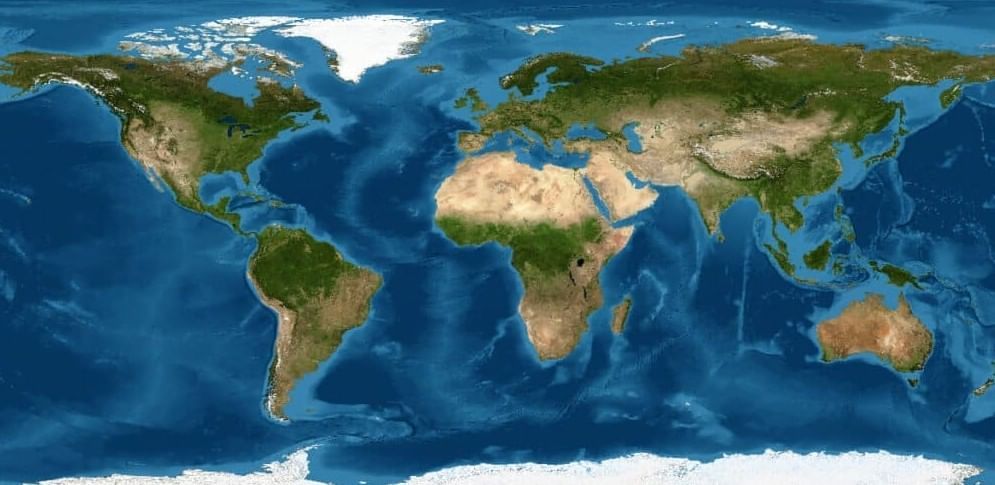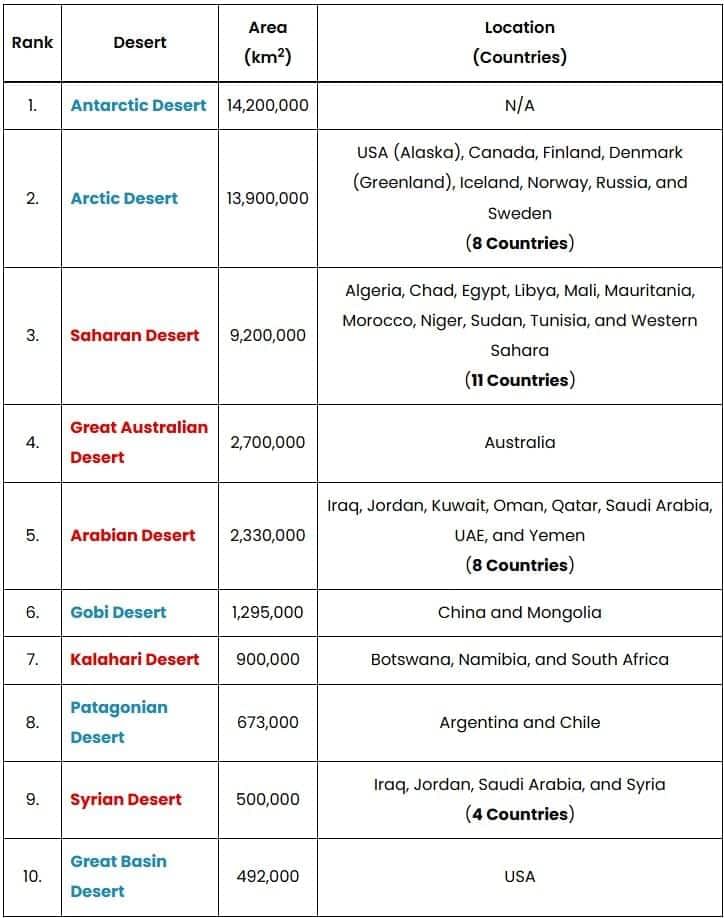Class 1 Exam > Class 1 Notes > General Knowledge for Young Learners > Major Deserts of the World
Major Deserts of the World | General Knowledge for Young Learners - Class 1 PDF Download
Introduction to Deserts
A desert is primarily characterized by its low levels of precipitation, typically receiving less than 25 centimeters (about 10 inches) of rain per year. This limited rainfall is what distinguishes deserts from other types of landscapes. It's a common misconception that deserts are always hot and covered with sand. In reality, some of the largest deserts in the world are cold. For instance, the Antarctic Desert and the Arctic Desert are both cold deserts, despite their vast size. Other examples of cold deserts include the Gobi Desert in Asia, the Patagonian Desert in South America, and the Karakum Desert in Central Asia. When we talk about deserts outside the polar regions, the Sahara Desert in Africa is the largest. The Sahara is a subtropical desert, which means it is hot, and it holds the title of the largest hot desert in the world. Deserts in the World
Deserts in the World
Top 10 Largest Deserts of the World
The table below provides a list of the 10 largest deserts in the world, along with their locations and approximate areas in square kilometers.Please note that the cold deserts are highlighted in bluish color and the hot deserts in reddish color.

Important Facts about World’s Deserts
- Largest Desert: The Antarctic Desert is the largest desert in the world, covering an area of 14.2 million square kilometers. It is followed closely by the Arctic Desert, which spans 13.9 million square kilometers.
- Largest Hot Desert: The Sahara Desert holds the title for the largest hot desert, with an area of 9.2 million square kilometers.
- Smallest Desert: The Carcross Desert in Yukon, Canada, is often regarded as the smallest desert in the world, covering only about 2.5 square kilometers.
- Driest Non-Polar Desert: The Atacama Desert is the driest non-polar desert and the only hot desert that receives less precipitation than polar deserts. Its extreme lack of rainfall is its most defining feature, earning it the reputation of being the driest place on Earth.
- Inhabitants of the Atacama: Despite its harsh conditions, the Atacama Desert is home to around 1 million people who primarily rely on underground aquifers for water.
- Global Coverage: Deserts make up more than one-fifth of the Earth's land area and are present on every continent.
- Desert Expansion: The size of deserts is increasing, with approximately 120,000 square kilometers of land becoming desert each year. This expansion is mainly driven by climate change and human activities like deforestation.
- Fastest-Growing Desert: The Gobi Desert is the fastest-growing desert, expanding by over 3,600 square kilometers annually.
- Antarctic Desert: Antarctica, home to the Antarctic Desert, is the only continent entirely covered by a desert. Despite being one of the driest places on Earth, the Antarctic Desert contains about 90% of the world's freshwater, stored as permanently frozen ice sheets.
- Oldest Desert: The Namib Desert in Southwestern Africa is considered the oldest desert in the world, estimated to be between 55 to 80 million years old. In contrast, the Sahara Desert is much younger, estimated to be 2 to 3 million years old.
The document Major Deserts of the World | General Knowledge for Young Learners - Class 1 is a part of the Class 1 Course General Knowledge for Young Learners.
All you need of Class 1 at this link: Class 1
|
64 videos|153 docs|40 tests
|
FAQs on Major Deserts of the World - General Knowledge for Young Learners - Class 1
| 1. What defines a desert, and what are its main characteristics? |  |
Ans. A desert is defined as a region that receives very little precipitation, typically less than 250 millimeters (10 inches) per year. Main characteristics of deserts include extreme temperature variations between day and night, sparse vegetation, and specialized wildlife adapted to arid conditions. Deserts can be classified into hot deserts, like the Sahara, and cold deserts, such as the Gobi.
| 2. What are the top 10 largest deserts in the world? |  |
Ans. The top 10 largest deserts in the world, by area, include:
1. Antarctic Desert
2. Arctic Desert
3. Sahara Desert
4. Arabian Desert
5. Gobi Desert
6. Kalahari Desert
7. Patagonian Desert
8. Great Victoria Desert
9. Syrian Desert
10. Great Basin Desert.
These deserts vary significantly in climate, vegetation, and wildlife.
| 3. Why are deserts important for the ecosystem? |  |
Ans. Deserts play a crucial role in the global ecosystem. They help regulate the Earth's temperature by reflecting sunlight and influencing weather patterns. Additionally, deserts are home to diverse species that have adapted to extreme conditions, contributing to biodiversity. Furthermore, they serve as carbon sinks, helping to mitigate climate change.
| 4. What are some common misconceptions about deserts? |  |
Ans. One common misconception is that all deserts are hot and sandy; however, many deserts, like the Gobi and the Great Basin, are cold and rocky. Another misconception is that deserts are lifeless; in reality, they host a variety of life forms, including plants and animals that have adapted to survive with minimal water.
| 5. How do human activities impact deserts? |  |
Ans. Human activities such as urbanization, agriculture, and mining can significantly impact deserts. These activities often lead to habitat destruction, soil erosion, and water depletion. Additionally, climate change, driven by human actions, can exacerbate desertification, making arid regions even drier and impacting local ecosystems and communities.
Related Searches




















